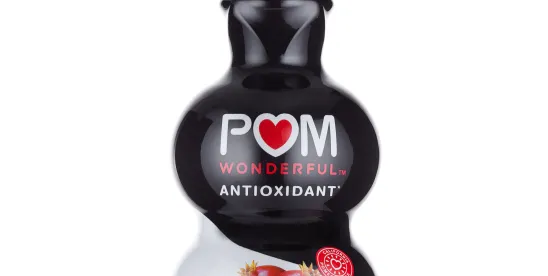In 2015, the FTC prevailed in litigation against POM Wonderful, makers of pomegranate juice. POM Wonderful LLC, et al., v. Federal Trade Commission, 773 F.3d 487 (D.C. Cir. 2015). The case involved the FTC's assertions that POM had inadequate substantiation to support advertising claims the Commission alleged POM was making: such as that drinking the juice daily had been shown in clinical studies to treat, prevent or reduce the risk of heart heart disease, prostate cancer, and erectile dysfunction.
The D.C. Circuit noted that there had been a dispute between the FTC and POM regarding the precise meaning of the claims at issue, which had a significant impact on the decision below, but it ultimately deferred to the FTC ‘s own expertise in advertising interpretation: “The question whether a ‘claim of establishment is in fact made is a question of fact the evaluation of which is within the FTC’s peculiar expertise.’ Thompson Med. Co., 791 F.2d at 194; see also Removatron, 884 F.2d at 1496. Here, we perceive no basis for setting aside the Commission’s carefully considered findings of efficacy and establishment claims as unsupported by substantial evidence.”
The issue of whether to defer to the FTC on advertising interpretation is likely to recur and can determine the course of an investigative process. The FTC need not conduct consumer research in order to issue a civil investigative demand. Staff attorneys are, with oversight, permitted to draw conclusions regarding advertising interpretation. Negotiations with senior FTC officials regarding their findings frequently boil down to a battle of whose interpretation is better. And, FTC staff will frequently remind the investigation target that the FTC routinely applies its judgment in determining what it perceives are likely messages conveyed, and that such interpretative judgment will receive deference because of the FTC's expertise in the area.
The question arises, however, in light of the recent Supreme Court decision to overrule Chevron in the Loper Bright decision (Loper Bright Enterprises v. Raimondo, No. 22-451 (S.C.T., June 28, 2024), may the FTC continue to invoke such deference when it interprets ads? After Loper Bright, will the courts henceforth hold that the FTC is better equipped than a court to determine the meaning of claims implied by advertising?
A brief refresher of Chevron and Loper Bright helps frame the question. In Loper Bright, the petitioner challenged a rule by the National Marine Fisheries Service (NMFS), ostensibly pursuant to its statutory authority to craft fishery management plans, which required vessels in certain fisheries to carry and pay for independent catch observers onboard. The petitioners argued that the statute did not provide for such payment and that the agency's interpretation otherwise was contrary to law. In defense of its rule, NMFS invoked Chevron, arguing that because the statute was silent on the point, it was empowered to fill that gap by making industry pay for the costs of compliance, which was a well-established norm.
The Court's majority seized the opportunity to overrule its nearly 40-year old precedent of administrative law, Chevron v. Natural Resources Defense Council, 467 U.S. 837 (1984). In the Chevron case, which shaped decades of administrative law practice thereafter, a quorum of the Court had held that the courts were required to defer to administrative expertise where the statute was ambiguous or silent as to an issue committed to the agency. That approach, said the Loper Bright Court, could not be squared with Section 706 of the Administrative Procedure Act (APA), which predated Chevron by decades. Thus, the Court held, Chevron deference would no longer apply. Courts, not agencies, would henceforth interpret statutory ambiguities and fill in gaps – unless the statute clearly delegated authority to the agency to do so.
To be sure, there is an obvious distinction between the statutory gap-filling attempted by NMFS and the fact-finding used by the FTC in typical enforcement cases (assessed by the POM court under a substantial evidence standard of review). One might reasonably argue that deference can and should continue to the FTC's findings of fact on matters of advertising interpretation. However, the FTC also engages in rulemaking and its rules depend on predicate findings that deceptive or unfair conduct is “common”, which in turn may depend on the kind of interpretative work discussed above. See Section 6 of the FTC Act, 15 U.S.C. Sec. 46. Enforcement by the FTC is more often these days predicated on allegations of rule or order violations, which give the agency a hook to demand money.
Moreover, the FTC can obtain monetary sanctions only if it can show that the defendant had “actual knowledge that such act or practice is unfair or deceptive and is unlawful”; see Sec. 5(a)(1) of the FTC Act.) Whether a defendant had such knowledge is often disputed and could foreseeably also invoke issues of rule and statutory interpretation.
Much remains to be determined. While there are few direct references to Chevron deference in published FTC cases, the specters of Chevron, and now Loper Bright, lurk. It remains to be seen how the Court's new Loper Bright decision will impact FTC enforcement practices or whether it will embolden more defendants to resist the FTC in court rather than settle.
Next week, we will discuss Jarkesy, another Supreme Court decision that threatens to upend the FTC's structure and way of working.




 />i
/>i

